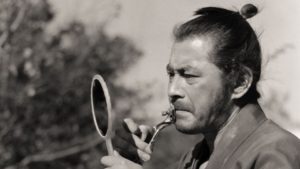STUDIO: Strand Releasing | DIRECTOR: Steven Okazaki
RELEASE DATE: April 25, 2017 | PRICE: DVD $14.52
SPECS: NR | 80 min. | Documentary | English and Japanese with English subtitles
RATINGS (out of 5 dishes): Movie| Audio
| Video
| Overall
Steven Okazaki’s Mifune: The Last Samurai is a compact, highly informative documentary on the life and career of Toshiro Mifune, Japan’s most celebrated movie star.
It is ironic that the actor who best represented the brilliant era of post-WWII Japanese filmmaking was actually born in China to Japanese nationals. His father owned a photo studio and often used his son in photos which reveal the innate performer. He first set foot in Japan after he was drafted into the Imperial army during the war. He was tasked with training young pilots for suicide missions, and, always the rebel, refused to tell them to shout “Banzai” for the Emperor. He told them, instead, to say goodbye to their mothers.
Amidst the misery and devastation after the war, movies became a popular diversion. The industry took off and Mifune, like a number of other future luminaries, took work as an actor to survive. It was at Toho Studios, in 1947, that he appeared in Snow Trail co-scripted by a young writer/director with whom he would make 16 films and become linked in cinematic history: Akira Kurosawa (High and Low).
Kurosawa carefully nurtured Miifune’s raw talent and in 1950, they made Rashomon. It won the “Golden Lion” at the Venice film festival and put Japanese cinema on the world map. The allied occupation forces had banned sword fighting films in Japan. In 1953, the ban was lifted and Mifune/Kurosawa made The Seven Samurai. Its balletic sword fighting scenes established Mifune’s iconic Samurai image.
 Fortunately, many of the actor’s co-stars as well as Kurosawa crew members are still alive and, in generous interviews, they provide fascinating insights into this inspired epoch. As Mifune had been nurtured, so he nurtured novice players. He reveled in stardom, indulging passions for cars and alcohol. “Dinner wasn’t over until Toshiro had finished the bottle” says one. They also talk about this “accidental actor’s” perseverance and work ethic. He studied the movements of lions for Rashomon and, terrifyingly, allowed student archers to shoot real arrows in his direction during the death scene from Throne of Blood (1957), the great Mifune/Kurosawa re-imagining of Shakespeare’s Macbeth.
Fortunately, many of the actor’s co-stars as well as Kurosawa crew members are still alive and, in generous interviews, they provide fascinating insights into this inspired epoch. As Mifune had been nurtured, so he nurtured novice players. He reveled in stardom, indulging passions for cars and alcohol. “Dinner wasn’t over until Toshiro had finished the bottle” says one. They also talk about this “accidental actor’s” perseverance and work ethic. He studied the movements of lions for Rashomon and, terrifyingly, allowed student archers to shoot real arrows in his direction during the death scene from Throne of Blood (1957), the great Mifune/Kurosawa re-imagining of Shakespeare’s Macbeth.
In 1965, Mifune and Kurosawa parted company. The director floundered for a while, eventually coming back magnificently with Kagemusha and Ran. Mifune took his star power west, most notably in Hell in the Pacific (1968) with Lee Marvin and Red Sun (1971) In the latter, he actually got the girl (previously unthinkable in a western film, and one with heartthrob Alain Delon). In 1980, he also appeared the TV mini-series Shogun.
Toho Studios encouraged him to set up his own production company and this seemed to dissipate his talents. Later, there was scandal and self-parody on television. He did make a cameo appearance in Spielberg’s 1941 and, on the advice of his American agent, turned down the role of Obi-Wan Kenobi in Star Wars (inspired by Mifune/Kurosawa’s The Hidden Fortress).
For film buffs not familiar with this “golden age” of Japanese cinema, The Last Samurai is essential. For those of us who grew up with these art-house classics, it provides background and fills in some blanks with a dignity and lack of sentiment that befits its subject.
One note: the excellent narrator is Keanu Reeves, far from his stoner roots.
|
Buy or Rent Mifune: The Last Samurai
on DVD
|
|---|
Leave a Reply